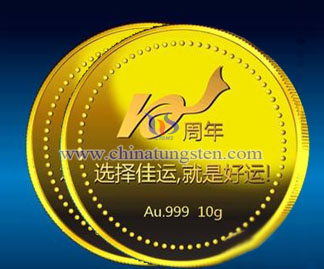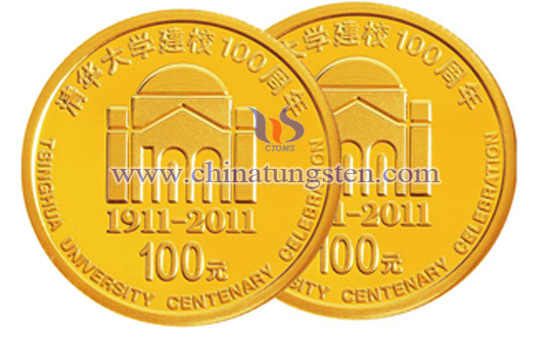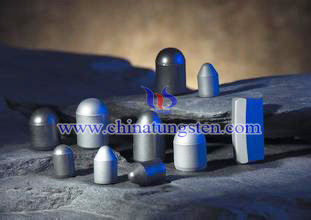Tungsten Gold-Plated Coin For Company Anniversary Celebration
- Details
- Category: Tungsten Information
- Published on Monday, 29 February 2016 18:20
- Written by yaqing
- Hits: 244

| Tungsten Gold Plated Supplier: Chinatungsten Online www.tungsten-alloy.com | Tel.: 86 592 5129696; Fax: 86 592 5129797;Email:sales@chinatungsten.com |
| Tungsten News & Prices, 3G Version: http://3g.chinatungsten.com | Molybdenum News & Molybdenum Price: http://news.molybdenum.com.cn |
Tungsten Gold-Plated Coin For School Anniversary Celebration
- Details
- Category: Tungsten Information
- Published on Monday, 29 February 2016 18:18
- Written by yaqing
- Hits: 243

| Tungsten Gold Plated Supplier: Chinatungsten Online www.tungsten-alloy.com | Tel.: 86 592 5129696; Fax: 86 592 5129797;Email:sales@chinatungsten.com |
| Tungsten News & Prices, 3G Version: http://3g.chinatungsten.com | Molybdenum News & Molybdenum Price: http://news.molybdenum.com.cn |
Tungsten Carbide Buttons Used for DTH Drill Mechanism (1/2)
- Details
- Category: Tungsten Information
- Published on Monday, 29 February 2016 17:36
- Written by xiaobin
- Hits: 244
DTH drill bit is a kind of high-performance tool, which is also the one of the most widely used in excavation, rock drilling work. It is suitable for drilling hard, hard and abrasive rock formations, relying on high impact energy have a great impact energy of rock cracking. And it has so many advantages, such as high efficiency of drilling, high impact energy, has shear crash and longer service life; especially its driving force is based on airflow, which sufficient airflow can take away the rock debris from the bottom to improve the efficiency of drilling and reduce the abrasion of tungsten carbide buttons. As for the choice of tungsten carbide button becomes essential, to be considered in accordance with DTH drill diameter as well as the impact on other aspects of work, number and position of the buttons determines whether a reasonable share DTH drill the impact on power.
Theoretically, tungsten carbide buttons used for DTH drill uses rotary impact for rock drilling, It has short impacting time, the buttons in an instant contact with the rock produces a huge impact and brittle rocks internal stress concentration, under the action of impact force generated volume very easily broken so that the efficiency of DTH drill has been improved. Furthermore, tungsten carbide DTH drill buttons while also impact rock rocks rotary cutting button and drill the ball pure axial pressure is significantly smaller than rotary cutting bit, the button wear is also reduced a lot , thereby improving the wear resistance and grinding of carbide DTH drill buttons, extended service life.

| Tungsten Carbide Supplier: Chinatungsten Online tungsten-carbide.com.cn | Tel.: 86 592 5129696; Fax: 86 592 5129797;Email:sales@chinatungsten.com |
| Tungsten News&Tungsten Prices, 3G Version: http://3g.chinatungsten.com | Molybdenum News & Molybdenum Price: http://news.molybdenum.com.cn |
Tungsten Carbide Buttons Used for DTH Drill Mechanism (2/2)
- Details
- Category: Tungsten Information
- Published on Monday, 29 February 2016 17:37
- Written by xiaobin
- Hits: 247
To study the process of tungsten carbide DTH drilling buttons that can be summarized as follows several stages:
Stage I: Cracks emerge, at this stage tungsten carbide buttons just contact with the rock surface, rock stress is transmitted to the contact surface has not been fully released, brittle failure in the contact surface, meanwhile accompanied by the generation of micro-cracks;
Stage II: With the increasing stress, the rock contacted with tungsten carbide button has plastic deformation and forms cracking area;
Stage III: On the boundary of the region will have been pulverized tensile stress cracks, and gradually developed into an initial crack, the crack will be increasing stress and further expansion;
Stage IV: With the increase of stress, both side of the initial crack formation and generates corresponding tensile stress crack, was extended obliquely downward;
Stage V: Cracks form a funnel-shaped expanding and consequential damage leap forward.
In addition, except that the study on the mechanism of tungsten carbide DTH drill buttons, we should also notice that although tungsten carbide buttons have higher hardness and impact resistance, it is brittle and has lower wear resistance. The main pattern of invalid is corrosion, which includes grain wear, surface fatigue wear as well as adhesive wear. It is mainly due to in the process of drilling, the high temperature of the high-speed collision with rock buttons occurrence arising will make carbide hardness decreased and crushed quartz particles made of a soft but opposed the hard phase transition occurs. Therefore, It also put forward tungsten carbide buttons higher requirements, which can be added some element or coated with a high-performance materials to improve the wear resistance of the tooth carbide buttons.
| Tungsten Carbide Supplier: Chinatungsten Online tungsten-carbide.com.cn | Tel.: 86 592 5129696; Fax: 86 592 5129797;Email:sales@chinatungsten.com |
| Tungsten News&Tungsten Prices, 3G Version: http://3g.chinatungsten.com | Molybdenum News & Molybdenum Price: http://news.molybdenum.com.cn |
An Invention for APT/AMT Production-Examples
- Details
- Category: Tungsten Information
- Published on Monday, 29 February 2016 17:34
- Written by xinyi
- Hits: 241
EXAMPLE I
| AMT Supplier: Chinatungsten Online www.ammonium-metatungstate.com | Tel.: 86 592 5129696; Fax: 86 592 5129797;Email:sales@chinatungsten.com |
| Tungsten News&Tungsten Prices, 3G Version: http://3g.chinatungsten.com | Molybdenum News & Molybdenum Price: http://news.molybdenum.com.cn |





 sales@chinatungsten.com
sales@chinatungsten.com